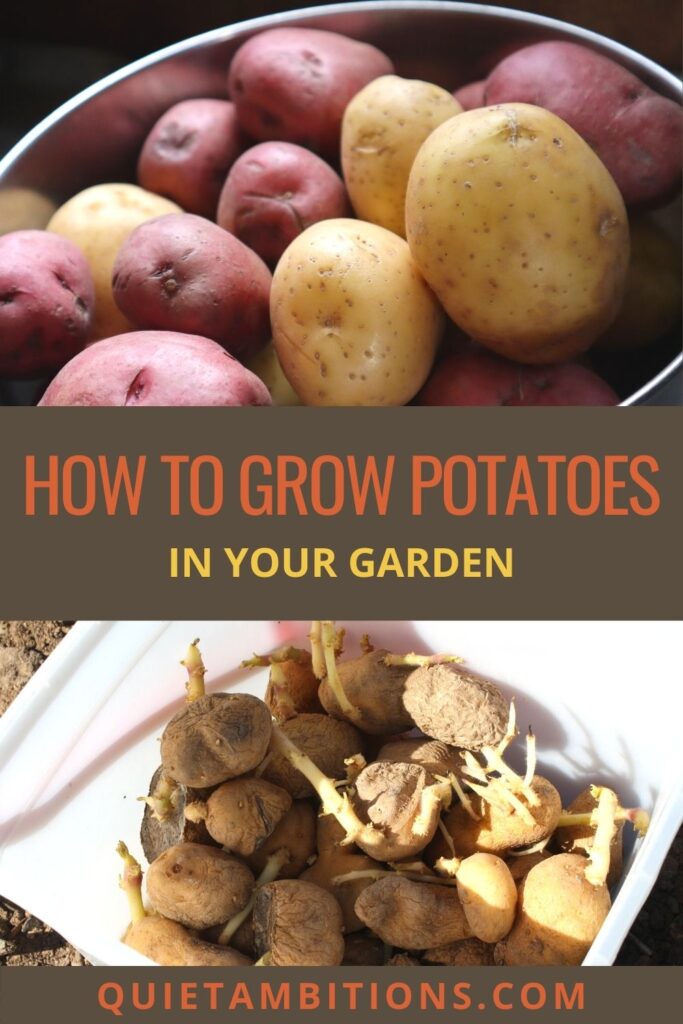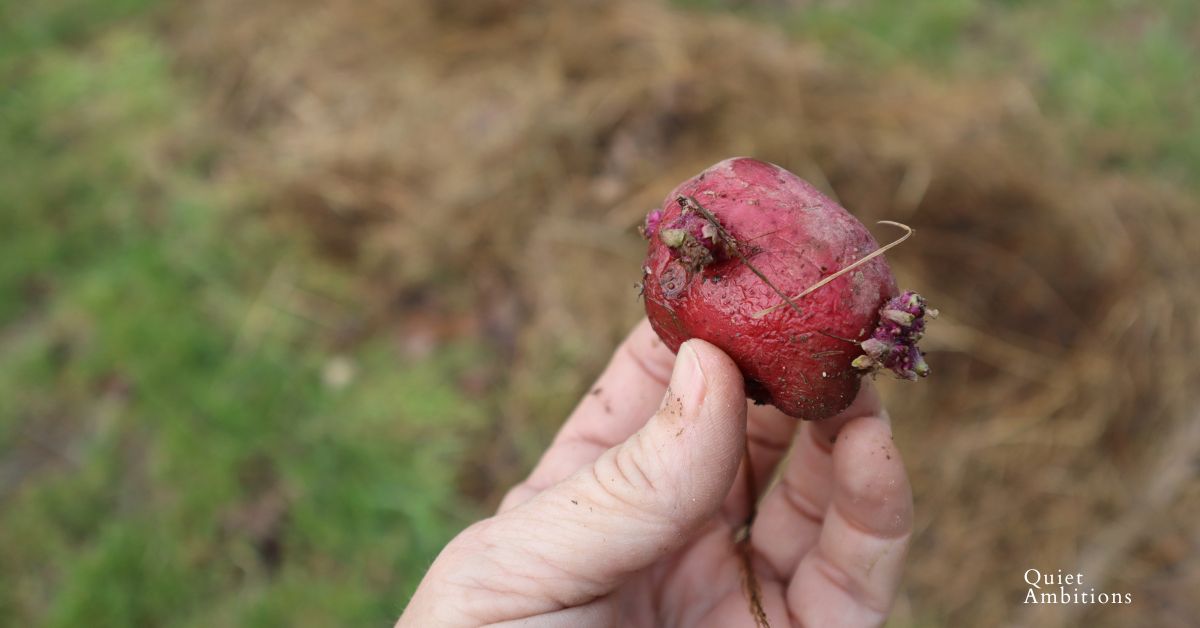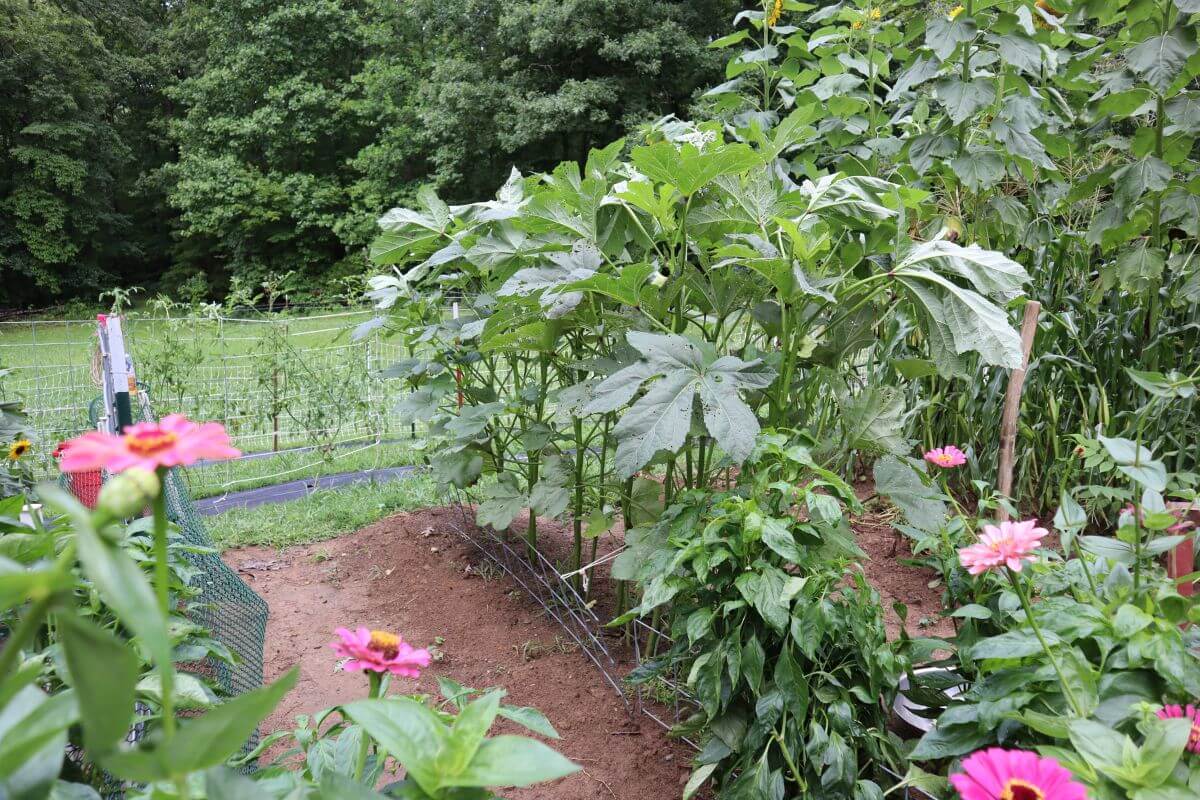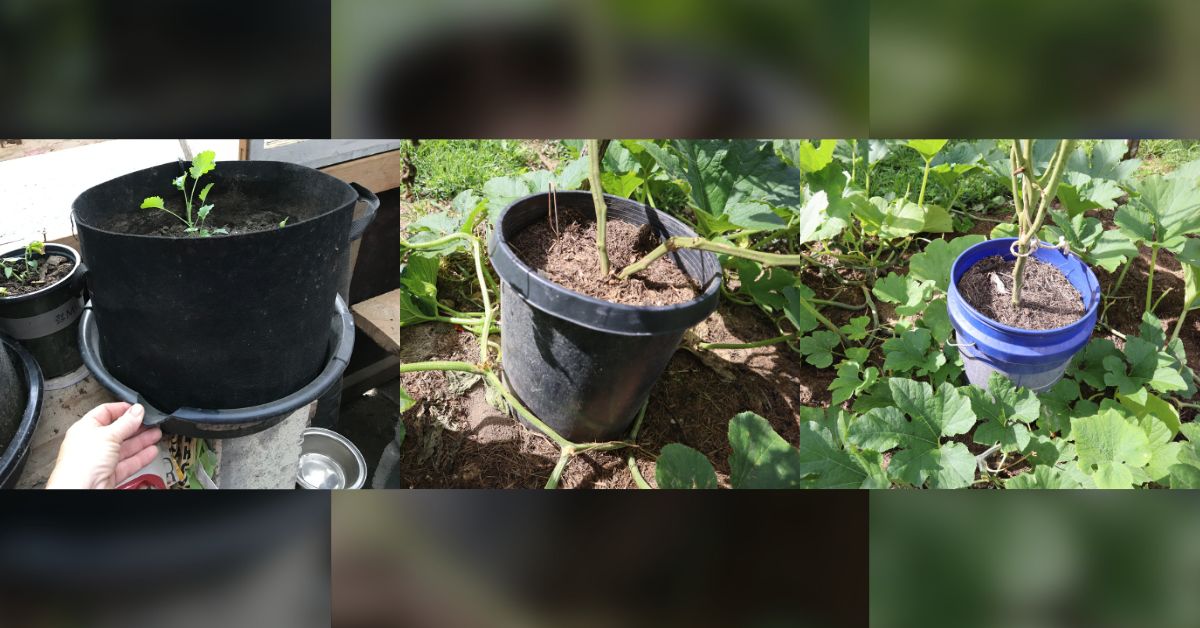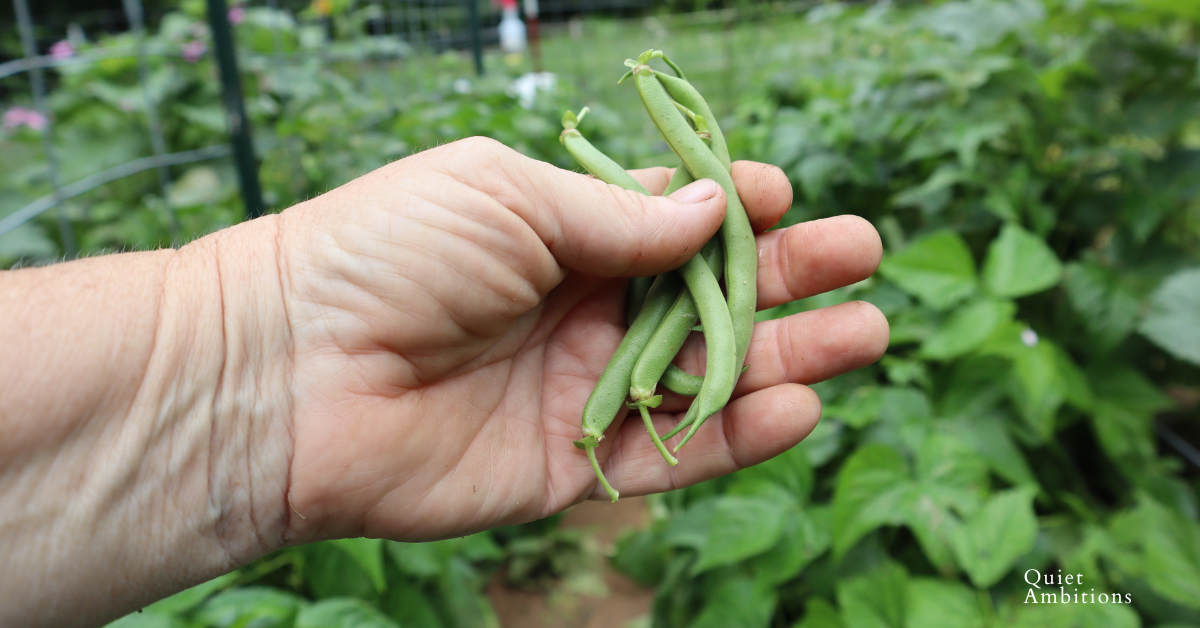How to Grow Potatoes in Your Garden
There are many different crops you can grow in a garden, but learning how to grow potatoes ensures you have a full supply of baked, fried, and mashed potatoes! While they require a little more heavy work than other garden crops, they’re still an excellent choice, especially if you have plenty of garden space. Here’s a step-by-step beginner’s guide about how to grow potatoes!
“I do not believe that you have to spend a lot of money to eat well: it is hard to beat a plain old baked potato.“
~Laurie Colwin
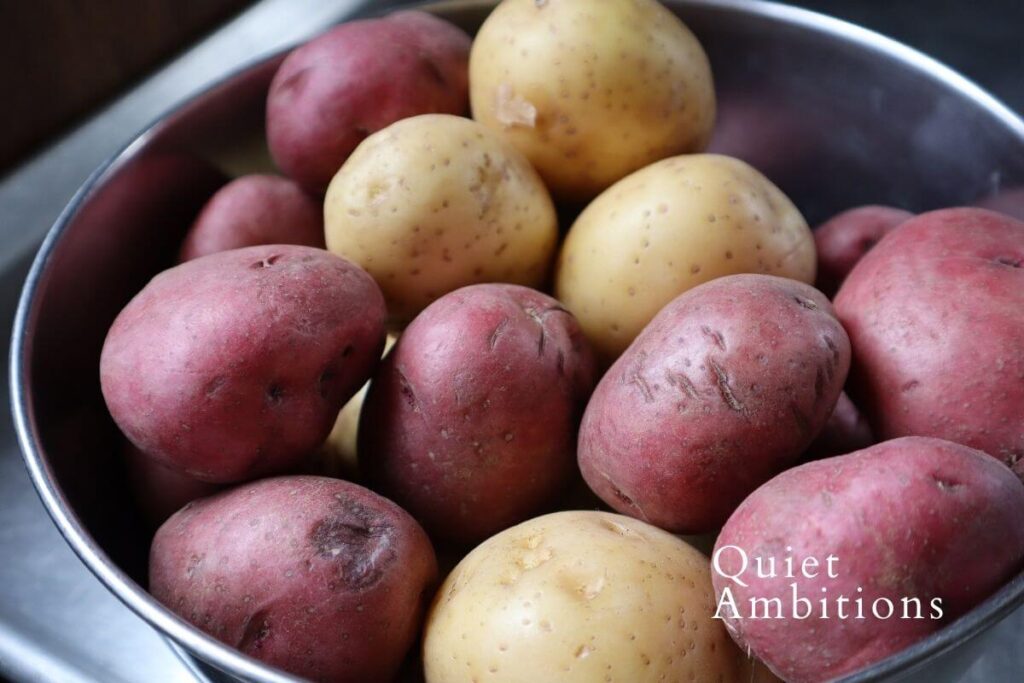
How to Grow Potatoes Quick Tips
- Suggested Soil Temp: 45-55 degrees F
- When to Plant Indoors: NA
- When to Plant Outdoors: 4 Weeks Before Last Spring Frost to 2 Weeks After Last Spring Frost (opinions vary on this)
- Seed Potato Depth: 6 to 9 inches of soil
- Days to Germination: 12 to 16 days
- Spacing: 12” to 15”
- Light Requirements: Full Sun
- Watering Requirements: 1” to 2” water per a week
- Good Companions: Garlic, Basil, Beans, Horseradish, Oregano, Peas, Catmint, Cilantro, Spinach, Lettuce, Cabbage, Corn
- Bad Companions: Tomato, Eggplant, Pepper, Cucumber, Pumpkin, Squash, Onion, Fennel, Carrot, Turnip
Planting Potatoes
Types of Potatoes
There are probably a hundred different types of potatoes with many names. They come in all shapes and sizes, from fingerlings that tend to be small and thin, to baking potatoes that are many times bigger. They come in many colors as well, including white, golden, and yes, even purple. Yellow flesh, white flesh, and yes… purple potatoes have purple flesh too!
These all fall into 2 categories. These are categorized by when to plant and how long it takes to harvest. Early season and maincrop (or late season) potatoes. Quite simple actually. Early potatoes are planted a little earlier and will be ready for harvest earlier. Maincrop potatoes will take longer to mature and are a fall harvest.
The topic of types of potatoes can actually get pretty involved. There are two ways to categorize potatoes. There is actually a bit of controversy when you start categorizing potatoes. (who knew?) And what you believe will determine how you grow potatoes. Learn more about Types of Potatoes here.
When Should You Plant Potatoes?
I’ve heard quite a few suggestions floating around depending largely on your location. Some common planting times include planting potatoes on St. Patty’s Day.
Potatoes are a cold-hardy plant so they will be planted in early spring, but you need to balance that with not letting the plants go through a hard frost. 2- 3 weeks before your spring frost-free date is about right. Although some do plant earlier than that and some don’t want to risk that frost. Potatoes should be planted when the soil is at least 45 degrees F. They can withstand a light frost.
Seed Potatoes
Home gardeners don’t usually start potatoes from seeds! Instead, you plant pieces of sprouting potatoes called “seed potatoes”. Chitting is when the potato starts to sprout. Chits are just the bumps on the potatoes where they will start sprouting.
Seed potatoes are available at garden supply-type stores or can be ordered online from many different seed companies. Some companies focus just on potatoes and you’d be amazed at the variety they have available.
It is good to get your supply from a reputable source so you know you are getting disease-free seed potatoes. You might as well not start out with a problem without knowing it.
How to Grow Potatoes from Last Year’s Harvest
You can also use a saved batch of potatoes from last year’s harvest. These are some potatoes that I saved from last year. As you can see they have already started chitting (or sprouting). They are all shriveled looking. This is not a problem at all but I do need to get them in the ground. Leave on those sprouts when you plant them.
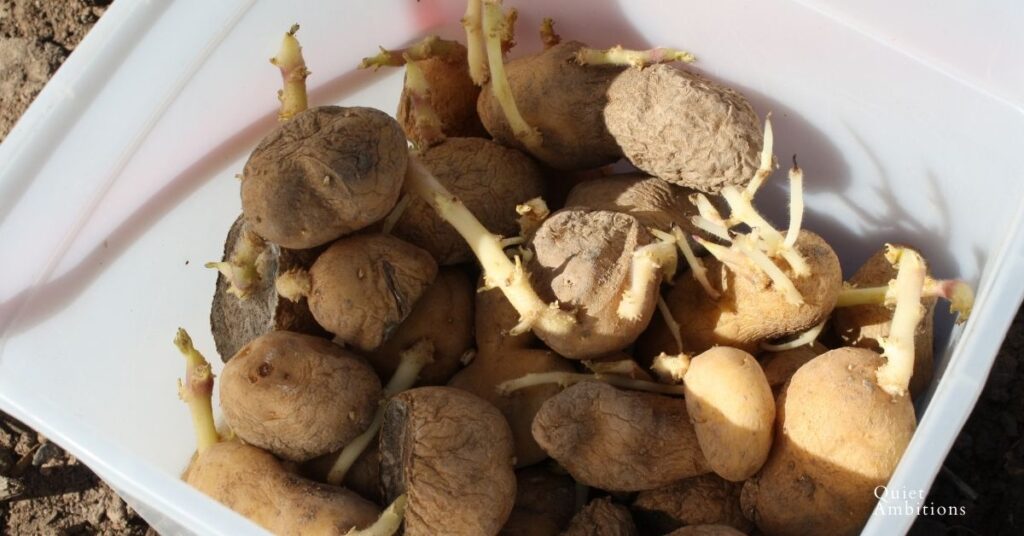
Planting Potatoes from the Grocery Store
You could even use organic potatoes from the grocery store, providing they have started showing signs of chitting so you know they will grow. Some conventional potatoes are treated to prevent sprouts and won’t grow well. Just be sure you get organic. Some grocery store potatoes have a growth inhibitor to prevent them from sprouting. Organics should not have been treated with this.
How to Prepare your Seed Potatoes
Seed potatoes have many “eyes”, which are the little bumps on the potatoes where the sprouts will emerge.
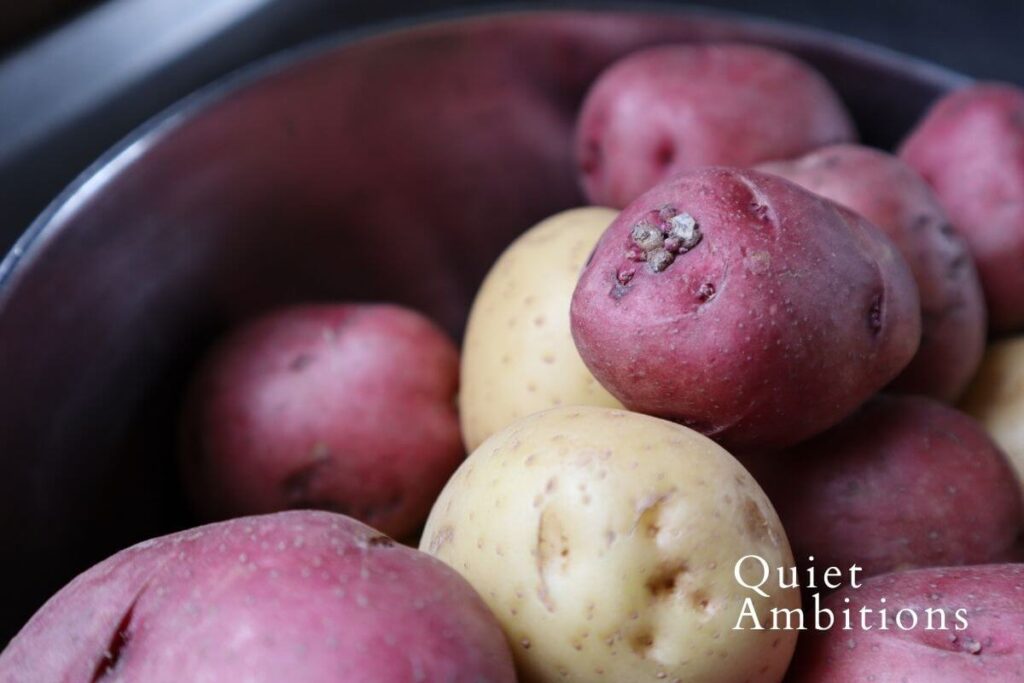
There are a variety of ways to prepare your seed potato. Traditionally you cut them into pieces before planting. Larger potatoes might be cut into more pieces than smaller potatoes. You’re aiming to get around two eyes minimum in each piece of seed potato. When you plant them, you should place the potato cut side down into the soil.
Some people prefer to just plant an entire potato without cutting it up. If the potatoes are already small this is a good idea. However, some insist that planting a whole potato (even a large one) will get better results. Personally, I’ll cut the large potatoes so I get more plants out of one potato. More plants mean more potatoes.
Or you can also just cut a larger potato in half. This can work well if you save some of your best potatoes from a previous year’s garden. This way you are propagating the best of the crop which should produce more ‘best of’ produce.
Treating Pieces
Seed potatoes may sometimes rot in the garden, especially if the weather is cool and wet, as is often the case in the spring. There are some suggestions for preventing this common problem.
What I do is cut the seed potatoes two to five days before I plant them and allow them to dry. The cut areas will dry and form a seal. This is said to form a barrier that prevents rotting once they’re put into the garden. (Link coming soon to a video of me chitting my potatoes.)
You may also treat the pieces with sulfur powder before planting. The sulfur powder can be purchased where you buy your seed potatoes. Occasionally I’ve seen seed potatoes sold precut and pretreated.
How to Plant Potatoes in Trenches
One of the most common planting methods involves planting seed potato pieces in shallow trenches. Place your seed potatoes 10-12 inches apart, keeping trenches about 3 feet apart.
You simply dig a 4” deep trench, then bury the potatoes in the bottom of the trench and cover with about 4” or so of soil. As your potatoes sprout and grow they’ll grow up taller than the trench. (Link coming soon to a video of me doing just this.)
When the potato plants are 4 inches or so above the trench I hill my potatoes. Hilling is simply bringing the dirt up around the base of the plant to cover the stem and any tubers that may end up exposed. (Link coming soon to a video of me doing just this as well!)
Now believe it or not hilling can be controversial.
- Hilling method one – As the plants grow in the row, you hill up the soil over the trench to be sure any potato tubers are covered. Cover the base of the plant, not the whole plant.
- Hilling method two – Another method of planting potatoes is to plant in a trench 4”-6” deep and then hill your potatoes several times. As soon as the plants have about 6 inches of growth you cover the whole plant with dirt leaving just a few inches of plant showing. Do this several times. This gives the potatoes more room to create more potatoes. As the plant grows more potatoes grow along the stems.
- Hilling method three is to use some sort of container to allow you to continue to hill your potatoes throughout the season. The theory is the more you can bury the more potatoes you’ll get.
Some say methods two and three are hogwash.
Remember above I mentioned there is some controversy regarding types of potatoes? This is where there is some disagreement. Determinate vs indeterminate. I’ll link that article here again because it is worth a read. Different Types of Potatoes
Me personally? I’ve always planted in a trench 4 inches or so deep and hilled my potatoes once or twice just covering the base of the stems. I’ll stick to what has worked in the past. But I’m not above experimenting! If I discover a new way I’ll report back!
I’ll cover hilling more below on this page to get more specific on the details.
No-Dig Planting for Potatoes
Let’s face it–one of the hardest parts about growing potatoes is the digging at harvest time, especially during the summer. That’s why some gardeners have experimented with planting methods like Ruth Stout’s that don’t require as much digging at harvest time. Plant your potatoes in straw.
Basically, you push your seed potatoes into the soil so they are still laying on top. Cover them with a thick layer of straw and add more straw if needed to keep the tubers covered as the plants grow. Then you can more easily harvest the potatoes from the ground level. No digging is needed. Just push around in the straw and find your potatoes. Sounds pretty easy. You can search on youtube for Ruth Stout Potatoes and you’ll likely find some examples.
So I had a bit of room and decided to give this a try! Link coming soon to a video of me setting my bed of potatoes growing in old hay and leaves.
Growing Potatoes in Containers
Did you know…you can actually grow potatoes in containers as well, especially if you don’t want a lot of heavy digging or have limited ground space? For people with heavy clay soil potatoes in containers might be a good idea. Early potatoes are the best choice for this method.
Options include planting potatoes in tires (I’m not a fan of this because of the chemicals in the tires, but there are some people who do it), buckets, fence rings, grow bags, and many types of other containers.
As long as the containers are no bigger than 3’ tall, they should work fine for growing potatoes.
Here are some things to consider about the soil you use while growing potatoes in containers:
When planting in containers, you’ll want loose soil, so it won’t become a brick once it’s wet! One soil recipe I found (https://www.gardendesign.com/vegetables/potatoes.html) says to use 1 part peat moss combined with 1 part organic potting soil and 1 part cow manure, but you can also use something like a mix of soilless growing medium and compost instead. I’ve also used half peat moss and half my garden soil. I have pretty good top soil. I would add compost if you have poor soil locally. Jus keep it light. Being in a container that dirt wants to compact.
In containers, potatoes will need about 5 gallons of soil per plant. The container has to be big enough to give the potatoes room to grow. You’ll want to add soil as needed on top as they grow to keep any tubers covered. Much like you would do for hills in the garden. Containers will also dry out more quickly than in-ground beds, so you’ll need to provide regular water.
Companion Planting
There are some companion planting considerations to keep in mind while growing potatoes as well.
Let’s start with antagonistic plants first. Potatoes are in the Solanaceae or nightshade family, which is a common family in the garden. Other crops in the same family include tomatoes, peppers, and eggplant. It’s generally a good idea to avoid planting these crops near potatoes since they deal with many of the same pests and diseases. A concentration of the family of plants may attract the pests more.
There are LOTS of other things you can plant next to potatoes instead, however, including garlic, basil, beans (all legumes fix nitrogen), peas, spinach, lettuce, cabbage, and corn.
You can also deter common pests with some crops too, like cilantro (deters aphids, spider mites, potato beetles), horseradish (deters Colorado potato beetles and helps soil pH), and catmint (also deters Colorado potato beetles).
Growing Potatoes
With a few preparations, growing potatoes is relatively easy! Now that we’ve covered planting potatoes, let’s dig deep (pun intended) into the growing time for potatoes. The usual care should be given to potato plants. Water, light, and weed control.
Hilling Potatoes
Remember I explained above that hilling potatoes simply means pulling the dirt up around the plant when it gets to around 6 inches tall. Potatoes can be hilled 2-3 times during the season to be sure the dirt remains around the plants and no large tubers push up to the surface. Stop hilling after the plant blooms.
The first reason for hilling is to keep any tubers away from the sun.
- Sunlight turns potato tubers green.
- Green potatoes may have a substance called Solanine.
- Solanine is toxic and should not be eaten.
Hilling your potatoes prevents this. You don’t have to use dirt to protect your potatoes, you can straw, leaves, and compost. The point is to keep the tubers covered.
Hilling also helps prevent weeds by smothering anything growing near the plant.
Hilling can help the plant stand up and not fall over.
Some say hilling creates larger tubers because of the room in the dirt, others say it is simply because it makes for a healthier plant and healthier plants will create bigger tubers.
Water Needs
Potatoes require about 1” to 2” of water per week. It’s a balance; too little water will prevent the potatoes from growing properly, while too much water will cause them to rot in the excess moisture. Misshapen potatoes are caused by watering too much after planting them, or not providing enough water in their early developmental stages, but you want to make sure to provide enough water around flowering as well. Stop watering as the plants begin dying back.
Light Needs
Potatoes need full sun in the garden. Just be sure to protect the potatoes themselves from the sunlight, which turns them green. This indicates Solanine. I don’t know the scientific explanation but, these green potatoes can be poisonous and should not be eaten.
Weed control
The best way to control weeds is to just get out there on a regular basis and pull any emerging weeds before they get away from you. You can use a hoe if you are very careful. Remember the potatoes are growing just under the soil. Don’t damage the potatoes in the weeding process.
Pests & Diseases
Potato Blight
Potato blight is a fungal disease of historical significance, caused by Phytophthora infestans. Signs of this disease include brown and yellow spots on the leaves, which left unchecked, could spread to the entire plant, including the potatoes underneath the soil, leaving them a rotten mess.
The easiest way to control it is prevention in the garden, using three-year crop rotation between nightshade crops and properly removing old plants from the garden. Some varieties of potatoes are considered resistant to blight as well.
Colorado Potato Beetle
Colorado potato beetles are pesky little striped insects that attack the potato plant, eating leaves with vengeance. Errr. Early maturing varieties of potatoes are less susceptible to adult infestations.
Manually remove the beetles from your plants.
Diatomaceous Earth is a natural powder that may be used for controlling young beetles. Spinosad spray is recommended for controlling stubborn infestations.
Potato Scab
Potato scab is a disease that affects potato tubers. It looks like scabs all over the skins. If severe it can cause pitting into the potato itself. It is a bacterial disease that will overwinter in the soil. Potato scab can also be spread from infected plants.
- Never save potatoes with scab for seed potatoes the following year.
- Rotate crops to avoid planting in an area where you’ve experienced scab. You should avoid that area for several years as the scab can remain for several years.
- Treat your seed potatoes with sulfur helps avoid the introduction of scab.
Planet Natural has some other suggestions for avoiding or treating scab.
Harvesting Homegrown Potatoes
When to harvest potatoes? Potatoes are ready to harvest when the plants begin dying back and turning brown. Dig a test potato and check the skin to make sure it’s mature. (You may harvest a few younger potatoes for fresh eating as soon as the plant flowers, but potatoes for storage take longer to mature.)
To harvest homegrown potatoes, you’ll need to dig or otherwise remove the swollen potatoes from the ground. Watch that you don’t slice them open if you’re using a spade or fork! Start digging outside the area where you think you’ll find the potatoes, then keep searching. This is actually kind of a fun activity. (haha, I like digging in the dirt) You never know what you will find.
How to Cure Homegrown Potatoes
Curing is simply allowing the skins of your potatoes to ‘harden’… sort of. They don’t really get hard but they will toughen up and dry a bit. This will allow the potato to store much longer.
After harvest, potatoes, like many other root crops, should be cured on top of the dry beds or in a cool, dry, dark interior space after harvest to prepare them for longer-term storage. Do NOT wash potatoes before storage! Just gently brush off any dirt and store them after the curing step.
Put any damaged potatoes, even small scrapes on the skins in your kitchen pantry and plan on eating them up. They will not store well long term.
Overwintering Potatoes
While I’ve never tried it, potatoes may be planted in the fall and overwintered for an earlier crop once the weather warms. This will only work in areas that don’t get extreme winters. It might work in the area I now live so maybe I’ll give it a try. One less thing to do in the spring.
How to Store Potatoes
Potatoes are one of the classic root cellar crops, stored for months under the proper conditions, providing they are cured properly. They need cool temperatures (somewhere around 35 to 55 degrees F is ideal), high humidity, darkness, and plenty of ventilation so they don’t rot.
Over time, homegrown potatoes may begin to sprout again, and you can use them as seed potatoes the following year. See my image above.
How Long Will Potatoes Last in the Pantry?
In the pantry, potatoes may last for months. Don’t store your potatoes with your apples or any other fruit. Fresh fruit gives off ethylene gas. This gas will cause the potato to sprout and will shorten storage length.
Canning Potatoes
Yes! You can can potatoes in chunks for easy mealtime. Then open a jar, heat it up, and you’re done. Learn how to can potatoes here.
Freezing Potatoes
You can also freeze potatoes. Though they don’t yield quite the same result as, say, canning. Blanch for 3 to 5 minutes before freezing or the potatoes will turn brown and be unappealing.
Dehydrating Potatoes
You can make your own dried potatoes with a dehydrator. Simply spread pieces over a dehydrator tray and allow to dry around 125 to 130 degrees F temp until dehydrated, then store in an airtight container. These are especially good for adding to soups!
Root Cellaring Potatoes
This simply means storing potatoes in a cool, dark place, such as a root cellar. This is the optimal condition for storing potatoes, so if you have this option, go for it!
Growing Potatoes FAQs
How Long Does It Take to Grow a Potato from a Potato?
It takes approximately 80 to 100 days to harvest mature potatoes grown from seed potatoes.
How Many Potatoes Do You Get From One Plant?
It varies a lot depending on the variety and growing conditions, but you can generally expect to harvest something like 8 to 14 potatoes per plant (or 50lbs of potatoes from 2lbs of seed potatoes).
Can You Eat Potatoes Right After Harvest? Are Tiny Potatoes Okay to Eat?
Yes! Very small potatoes are called “new potatoes” and have a slightly different flavor than the potatoes you might be used to, a fresher flavor. The tiny potatoes are indeed safe to eat too! 🙂 But be warned, they don’t keep well, so use them quickly.
Should You Pick Flowers Off Potato Plants?
Potato plants give up a stalk of purple flowers in the summertime. When a potato flowers it indicates that it is also putting on potatoes. This is a good thing! If you remove the flowers, the plant puts that energy into creating potatoes. I’m usually so busy that time of year that I forget. I’ve had no issues. So it is a good idea to snip them off, but not imperative.
How Tall Do Potato Plants Grow?
Potato plants can grow up to 40” in height, depending on the variety, of course.
Resources and Links
Another Early Spring Crop is Peas – Learn about Growing Peas
Related articles
Planting seed potatoes in hay and leaves. I usually use the good old-fashioned traditional method of planting directly in the dirt. And I still did that this year as well. BUT I wanted to experiment because I keep reading about planting potatoes in hay… and it sounds super easy. We all like easy in the garden. I’m going to give it a try.
Pin this to find later!
